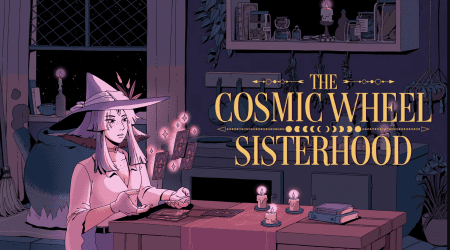I have a working theory that there are no video games for kids anymore. These days, there are more games than ever to play and obviously no shortage of children to consume the mountains of content, but is any of it actually for kids?
When I was younger, it felt like the vast majority of new releases were made especially for me and my peers. Maybe that’s my ego talking, but I rarely struggled to find a new platformer or adventure game that appealed to my interests. Aside from the Grand Theft Autos and Metal Gear Solids of the world, I felt like you couldn’t go 10 feet without bumping into Mario, Link, Banjo, Sonic, Spyro, Crash, Rayman, Sly, Ratchet, or any of the other countless cartoon faces synonymous with gaming in the early 2000s. Back then, video games still felt new, and the people most interested in them were young. The youths wanted to latch onto larger-than-life characters who were plastered all over TV and magazines (remember those?).
Fast forward to today, and it seems like everyone who was making games for kids back then is still making them for that same population. The only difference is they’ve grown up! All of a sudden, it feels like games fall into one of two categories: Either they’re gritty, adult action titles like God of War, Elden Ring, The Last of Us, and Uncharted, or they’re titles you grew up with that are packed with nostalgia and fan service—think your Legend of Zelda: Tears of the Kingdom, Yooka-Laylee, or Super Mario Bros. Wonder type games.
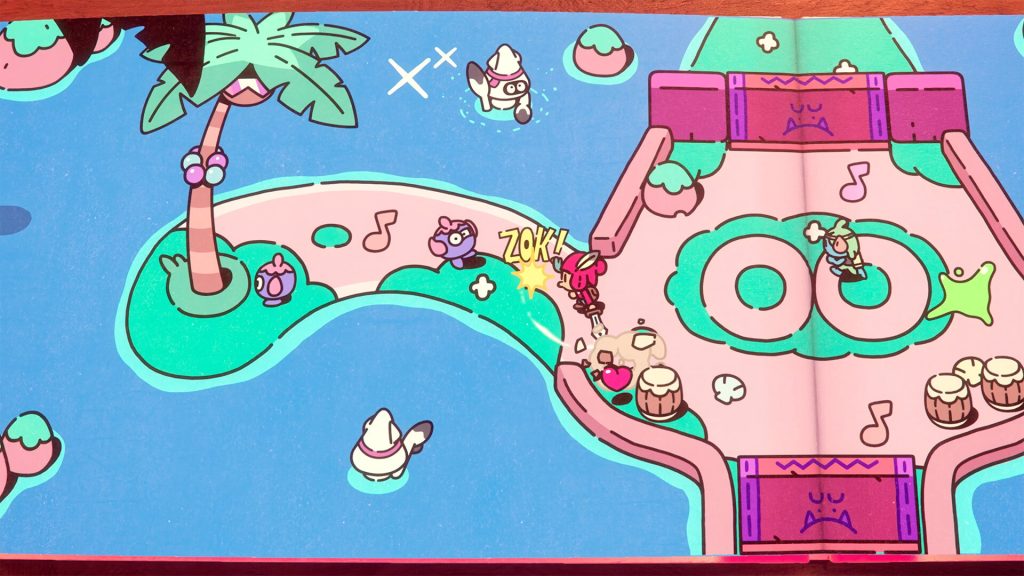
Now don’t get me wrong. I’m a sucker for the latter, as I still crave the types of experiences that can transport me back in time to my early days of gaming. I’ll be loyal to my pal Yoshi until the day I die, but it’s also nice to see fresh ideas that cater to those who might just be starting out on their gaming journey. That’s where The Plucky Squire comes in.
As someone constantly longing for the good old days of my childhood, I was immediately drawn to the game’s vibrant colors, cute characters, and storybook theme. As I dug into it, I realized it actually had its own unique path to pave and didn’t need to rely on pure nostalgia to create excitement or wonder. The Plucky Squire is an uber-endearing adventure that caters most effectively to kids, with all the positives and negatives that come with occupying that particular lane.
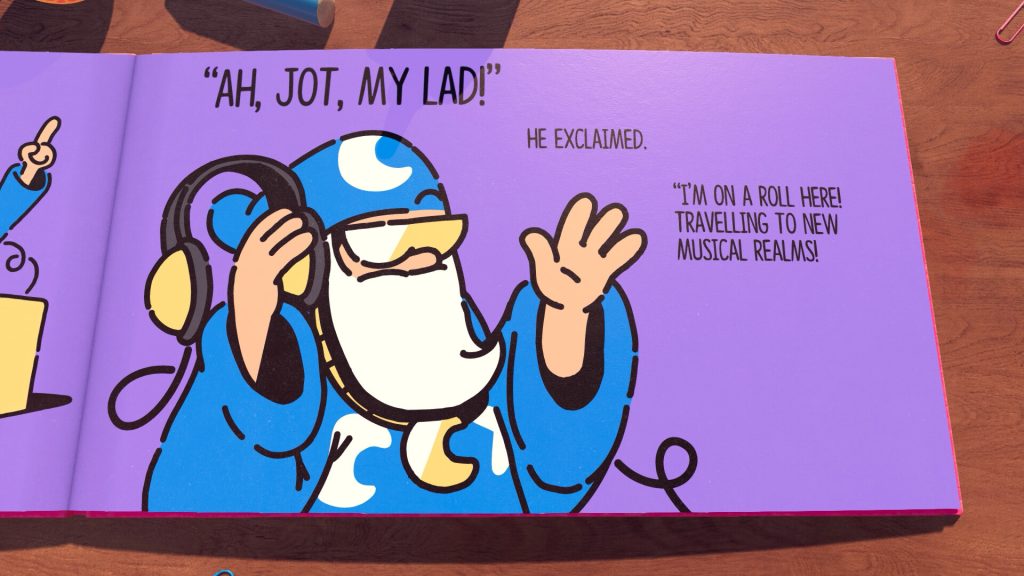
Jot That Down!
The plot of The Plucky Squire is equal parts simple, inventive, and just plain charming. Our journey begins with a quick zoom into a child’s room, giving some serious Andy from Toy Story vibes. There, we come across a storybook on their desk. As it flips open, a narrator quickly and efficiently sets the scene for our hero, Jot, otherwise known as The Plucky Squire. The voice acting and gorgeous 2D art immediately create an engrossing atmosphere and set up a story that proves to be a literal page-turner.
After getting up to speed with a short tutorial that tasks you with helping out your wizard pal, Moonbeard, it isn’t long before you’re introduced to the evil villain, Humgrump. Described as Jot’s primary rival, it is made very clear that he is definitely up to no good. In a fun, fourth-wall-breaking development, Humgrump explains that you both are actually characters in a book, but he has seen the ending, and, spoiler alert, it doesn’t end well for the guy named “Humgrump.” To alter his fate and the course of history as we know it, he decides to boot Jot clear out of the pages of the book and into the real world!
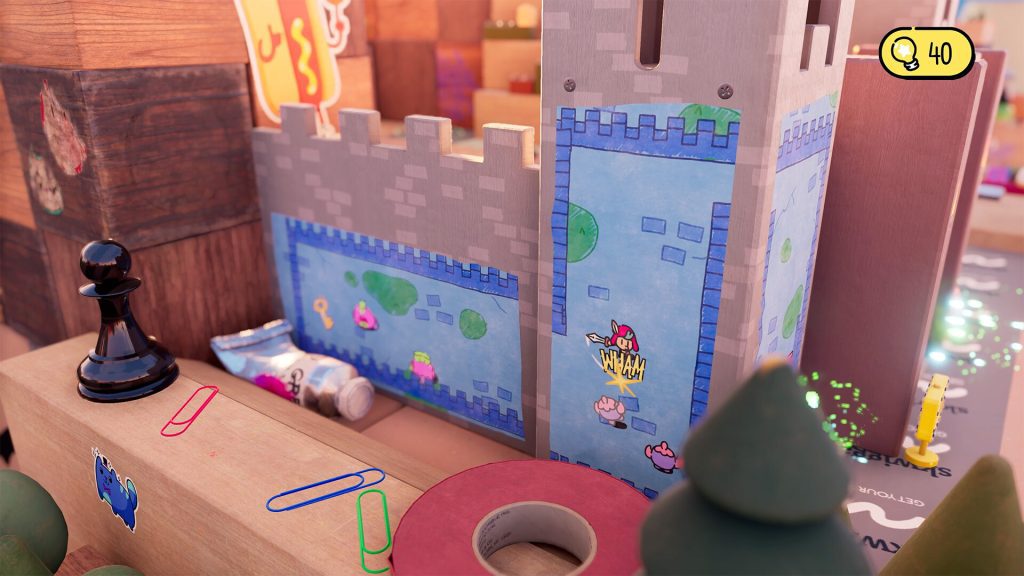
The jump from the 2D pages of your book to that 3D “real world” is a jarring one, and makes for an amazing transition in visual style. The Plucky Squire shares some clear common themes with Zelda: A Link Between Worlds, but instead of being a top-down dynamic, this game opens up fully into the 3D space. The art itself isn’t especially unique, and though some of the lighting effects are impressive, the character and enemy models were more good than great. Still, the core mechanic of moving between these two mediums is a creative trick I haven’t seen pulled off very often, so I’m willing to overlook the occasional rough edges.
To get back into your book, Moonbeard explains that you’ll need to explore the outside world to find a pair of gauntlets. These magical gloves will allow you to manipulate the land you call home. With this new power, Jot can flip open his self-titled chronicle and shuffle through pages at will as long as you’ve already read up to that point. Fully equipped and ready to defeat Humgrump, Jot sets off to write a new version of his story with a much happier ending!
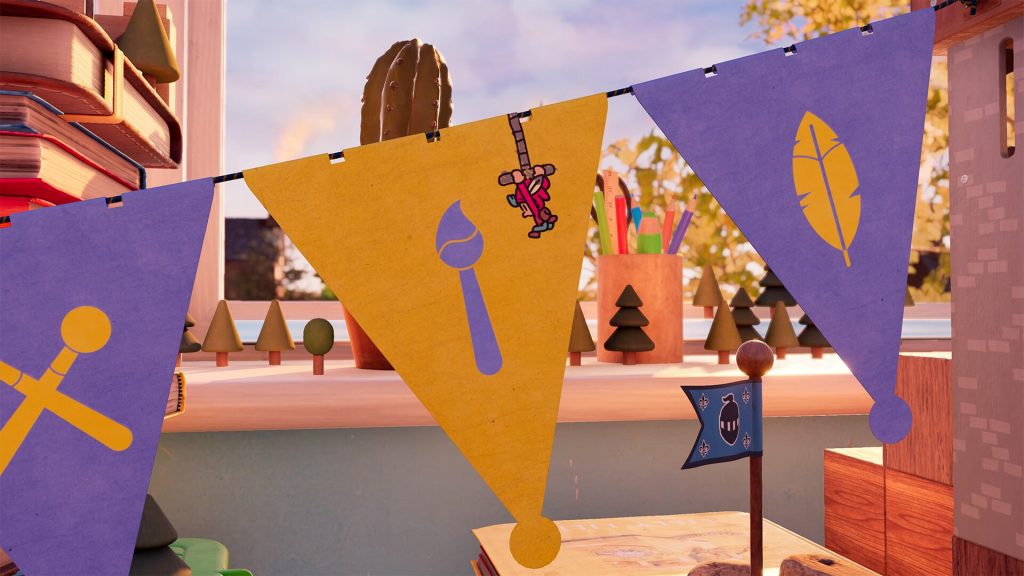
Adventure Time
Coming off of a riveting and perspective-shifting opening, I had high hopes for what was about to come my way. With multiple dimensions to play with, the possibilities seemed nearly endless! I was expecting a vast and open sandbox with abilities and powers galore, but my first red flag came when I realized there was no pause menu.
Before really settling into a game, I like to poke around the menus and see what information I can gather just from the empty slots or unfinished world map. Unfortunately, I was met with no such hints as to where my journey might lead, instead settling for your standard “Resume,” “Options,” and “Quit” (as well as a “Skip Minigame” button which I did appreciate). So, with my antennae up, I ventured on. For the next few chapters, Jot, along with his friends Thrash and Violet, traversed the world of Mojo, defeating monsters, solving puzzles, meeting allies, and getting closer to Humgrump, only leaving the confines of their publication when absolutely necessary.
The majority of The Plucky Squire’s gameplay takes place in the storybook, which makes sense to a certain extent but feels unnecessarily restrictive given what we know is just outside of its borders. There are some fun word-themed puzzles and snappy hack ‘n’ slash battles, but none of it feels particularly “novel.” (See what I did there?) The process was enjoyable most of the time, but I wasn’t exactly scratching my head when I needed to replace “closed” with “open” to pass through a gate to the next location. There’s almost no challenge to be found.
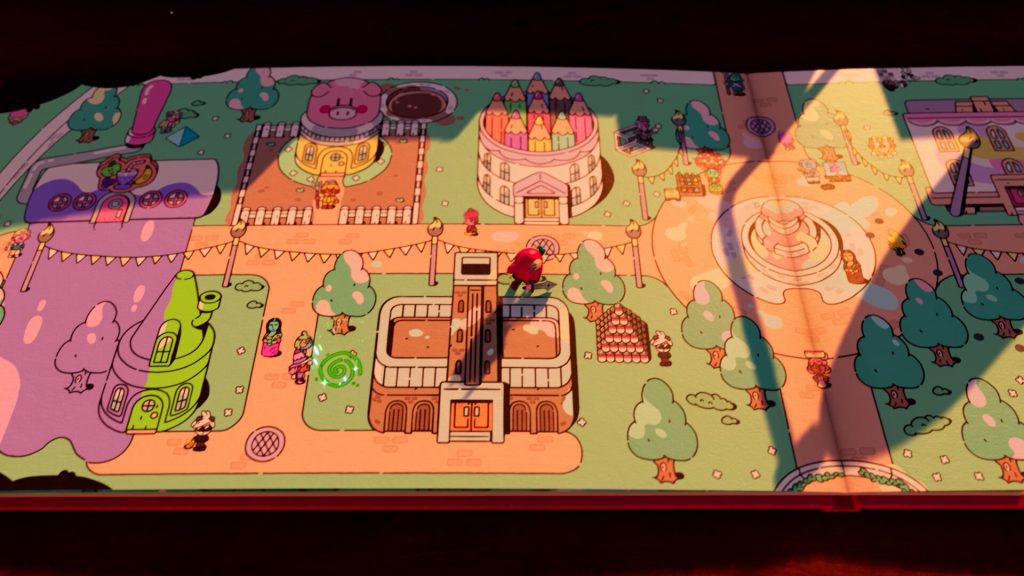
Ditching the Training Wheels
This is where I must reiterate that, at times, I felt like I was playing a game expressly designed for kids. In general, I consider that a positive, and through that lens, I give it high marks. I didn’t find the enemies hard to beat, but the swordplay was generally satisfying. Bouncing between worlds was consistently impressive, but it only happened when the game told you it needed to. The middle chapters tend to give Jot a few puzzles in the book and then block his path to force him out into the 3D space so he can find the specific item necessary to advance.
The unfortunate part is that the child’s room and desk area are only accessible in those moments when you actually have a goal to accomplish. I would have loved to have access to the space whenever I wanted, but unless you’re searching for something in particular, you can only follow your story as it’s written or hop out to turn the page.
To be clear, nothing here was bad, but a lot of the middle third of the game became very rinse-and-repeat, which left me wanting more. For a younger audience, though, there’s plenty here to engage with. The characters and their journey are absolutely a delight to watch, which at times is most of what you’re doing. But as a man rapidly approaching his 30th birthday, I could have benefitted from some more opportunity to color outside the lines.

Nasty Vegetables
At the risk of sounding overly negative, I also must mention the numerous bugs I encountered, which ranged from mildly annoying to actively game-breaking. Frustratingly, the critical act of manipulating the book was horribly laggy throughout my time with the game. There is no designated spot where you can take control of each page, so I would often find myself walking back and forth along the edge until the prompt appeared on screen. At that point, each flip was considerably delayed compared to the controller input, and there were several times when Jot froze completely or got pushed off screen while I waited for the story to reset itself.
With such a core piece of the gameplay being so buggy, there were times when I dreaded the back-and-forth of jumping between dimensions. I also experienced a page where battling enemies and exploring took place (not intentionally) in slow-motion, a page where I walked through the border and couldn’t make my way back, and multiple puzzles that were acting so wonky that I had to reset the game.
The worst part about these broken sections was that the game didn’t actually freeze or glitch out. Instead, I’d spend a significant amount of time scouring pages for a word that had disappeared or trying to find a party member whom I needed for assistance, but wouldn’t move. While there was a lot to like, there were several hours in the middle of the game that had me feeling a strange mix of joy, boredom, and pure frustration.
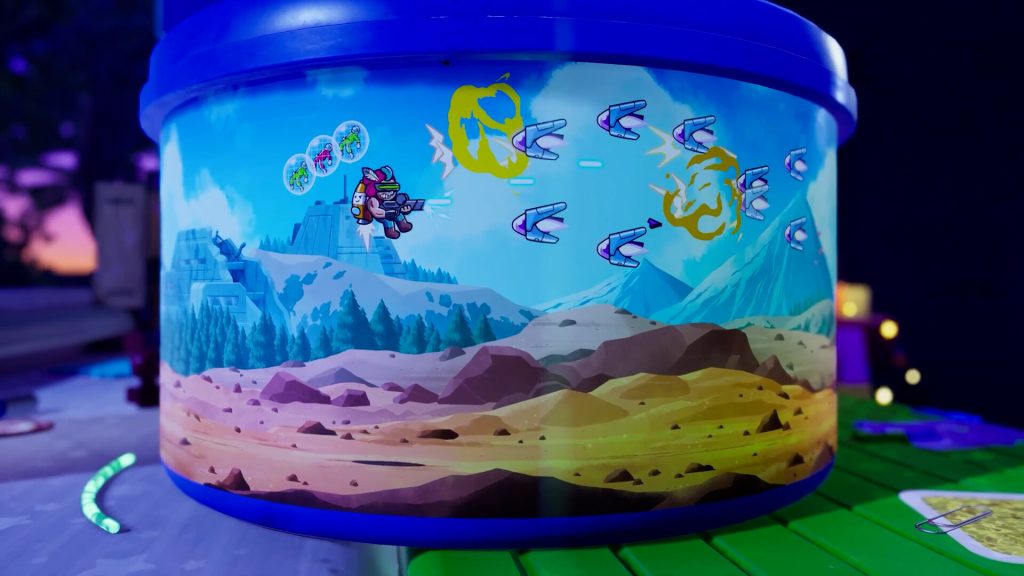
Putting the Plucky in The Plucky Squire
A quick Google search will tell you that “plucky” is defined as “having or showing determined courage in the face of difficulties.” That description feels fitting, since it takes a bit of time for The Plucky Squire to find its stride.
However, by the final third of the story, I finally felt the pieces come together. In the last few chapters, the narrative evolves significantly and subverts expectations a decent amount. It isn’t easy to get by solely on good looks and charm (believe me, I would know), and though those are consistently excellent, the gameplay did hold up its end of the bargain by the time the credits rolled.
It’s tricky to convey exactly how the game changes without spoiling the key turning point, but I would be doing The Plucky Squire a disservice if I didn’t say it was worth seeing through to the finale. Just before its conclusion, we experience a false ending and a brand new book, a stealth section with upbeat jazz tunes (and my favorite part of the game), some much more engaging battles with higher stakes, as well as darker themes including the loss of a loved one. The writing gets sharper and wittier too, which changes the overall tone and had me laughing out loud more than a few times.
Interestingly, nearly all of the best moments of the game take place inside the book, including the majority of the final stanza. Although I think there was more meat on the bone when it came to exploring The Plucky Squire’s multidimensional mechanic, the game was most effective when it instead focused its energy on the “source material.”
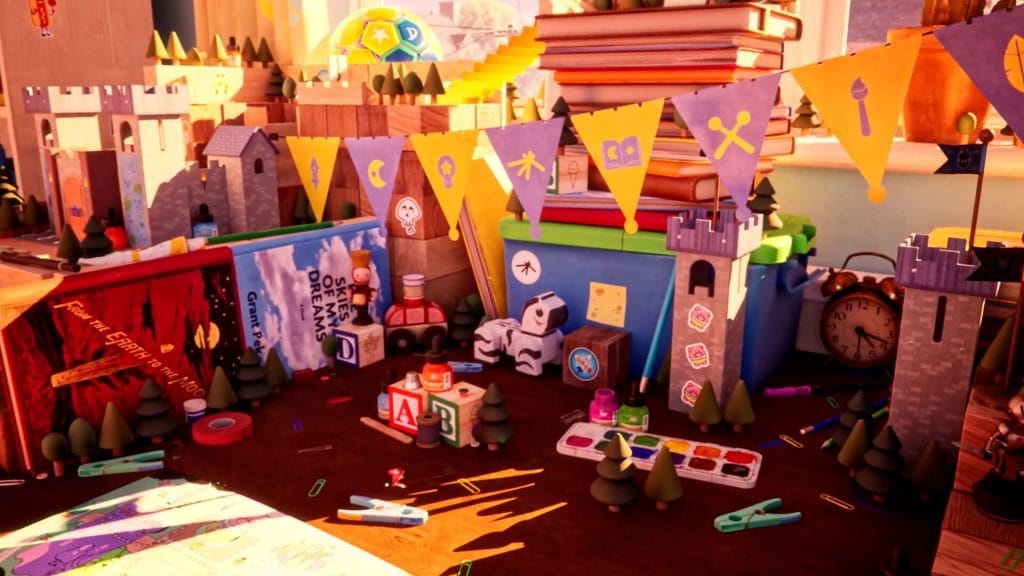
Final Thoughts
Despite some peaks and valleys, The Plucky Squire is a book worth getting lost in. I would certainly recommend the game, especially to families and those with little kids who might enjoy playing in the passenger seat. Even for those out there who are kids at heart, there’s plenty to enjoy—just be sure to stick it out until the end.
Score: 7.5/10
The Plucky Squire, developed by All Possible Futures and published by Devolver Digital, is available now on PlayStation 5, Xbox Series X/S, Nintendo Switch, and PC. MSRP: $29.99.
Disclaimer: A review code was provided by the publisher.
Zack has been hooked on games ever since his older brother taught him where to find the secret warp whistles in Mario Bros. 3. He has never felt more joy than when Yoshi congratulated him on getting 120 stars in Mario 64 or more sadness than when he played Kingdom Hearts 3 after waiting 14 years for it. Zack mails a letter to Nintendo every day asking them to bring back Chibi Robo and will gladly tell you all about why it’s one of the greatest games of all time. He was hoping that writing for the site would help him get through his backlog, but it actually just made it worse now that he’s hearing about so many more great hidden gems. Oops…








